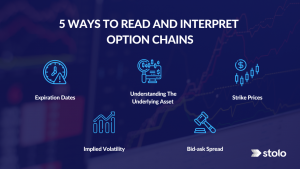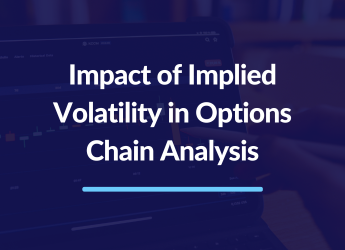If you are a trader, you already know the importance of option chain analysis. Understanding how to read and interpret option chains is crucial for making informed trading decisions. Let us explore five ways to read or interpret this article’s options chain.
What are Option Chains?
An options chain is a table or listing showing every option currently available for a specific underlying asset, such as a stock or index. It offers comprehensive details on each option, such as the strike price, expiration date, and premium. In addition to the bid and ask prices and other relevant variables.
Based on their trading techniques and market views, traders and investors may purchase or sell options with confidence thanks to the option chain. Option Chains are an essential tool for options traders. It can be found on most options trading platforms or financial websites.
5 Ways to Read and Interpret Option Chains

1. Understanding The Underlying Asset
Having a good knowledge of the underlying asset is the first step in comprehending an option chain. The stock, index, or any other financial asset on which the option is based is what we commonly refer to as the underlying asset.
The underlying asset must be evaluated, with its market price, volatility, and general trend. You may use this information to determine whether to buy or sell the options.
For example, if you are looking at an option chain for TATA (TATA), you should first understand the current market price of TATA stock, its volatility, and its recent trend. This can help you make an informed decision about whether to buy or sell TATA options.
2. Expiration Dates
Every option has an expiration date. This date represents the last day an option can be exercised. The ideal moment to purchase or sell an option may be determined by looking at the option chain, which displays all potential expiry dates. It’s crucial to select an expiration date that aligns with your trading strategies and expectations for the underlying asset.
For example, if you believe that TATA stock will rise in price over the next few months, you might consider buying call options with an expiration date several months later. Alternatively, if you believe that TATA stock will decline in price over the next few weeks, consider buying put options with a shorter expiration date.
3. Strike Prices
The price at which the option may be exercised is known as the strike price. Choosing a strike price that fits your trading style, risk tolerance, and market perspective are crucial. The option chain displays every strike price offered for a specific expiry date, making it simple to evaluate and select the best one for your requirements.
For example, if you are bullish on TATA stock and expect it to rise in price, you might consider buying call options with a strike price slightly higher than the current market price. Alternatively, if you are bearish on TATA stock and expect it to decline in price, you might consider buying put options with a strike price that is slightly lower than the current market price.
4. Bid-ask Spread
The bid-ask spread is the difference between the greatest price a buyer is ready to pay (the bid) and the lowest price a seller is willing to take (the ask). This may be used to estimate the options’ liquidity and prospective transaction costs. The liquidity of the underlying asset, the option’s expiration date, and the strike price can all affect the bid-ask spread. The bid-ask spread is a great way to read and interpret Option Chains.
For example, let’s take a bid-ask spread for a TATA call option with a particular expiration date, and the strike price is narrow. If they indicate high liquidity for the option, you may bag it for a high price. Inversely, if the bid-ask spread is wide, getting a favourable price may be more challenging.
5. Implied Volatility
Implied volatility measures the expected price fluctuation of the underlying asset. Considering the option’s implied volatility when making trading decisions is important. This is because it can impact the cost and potential profitability of the option. The option chain may provide an implied volatility column, or the Greeks, such as Vega, can be used to determine implied volatility.
Let’s retake TATA as an example. If the implied volatility of TATA options is high, the market expects significant price movement. This measure can then help make informed decisions, respectively.
Utilise more than one analytical tool to make the best trading decisions. Understanding the terms mentioned above and learning to use them can be beneficial in many ways. If you are looking to know more about option chains, Explore Stolo Options Trading Platform

